人文景观的文化蕴涵及其翻译
- 格式:pdf
- 大小:169.97 KB
- 文档页数:3
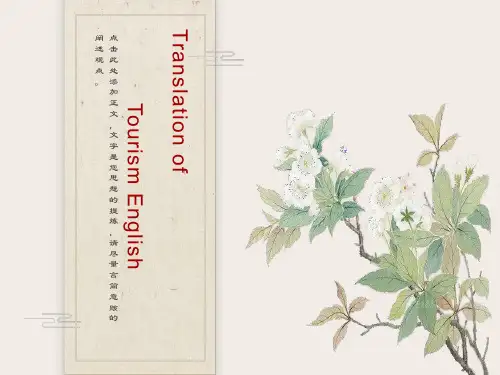
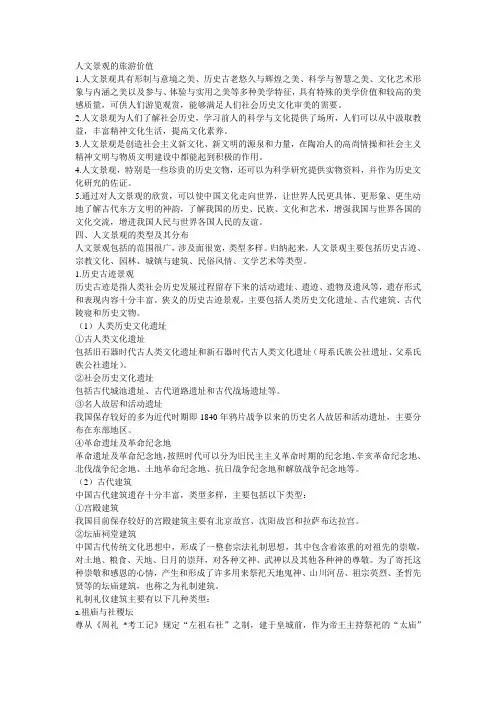
人文景观的旅游价值1.人文景观具有形制与意境之美、历史古老悠久与辉煌之美、科学与智慧之美、文化艺术形象与内涵之美以及参与、体验与实用之美等多种美学特征,具有特殊的美学价值和较高的美感质量,可供人们游览观赏,能够满足人们社会历史文化审美的需要。
2.人文景观为人们了解社会历史,学习前人的科学与文化提供了场所,人们可以从中汲取教益,丰富精神文化生活,提高文化素养。
3.人文景观是创造社会主义新文化、新文明的源泉和力量,在陶冶人的高尚情操和社会主义精神文明与物质文明建设中都能起到积极的作用。
4.人文景观,特别是一些珍贵的历史文物,还可以为科学研究提供实物资料,并作为历史文化研究的佐证。
5.通过对人文景观的欣赏,可以使中国文化走向世界,让世界人民更具体、更形象、更生动地了解古代东方文明的神韵,了解我国的历史、民族、文化和艺术,增强我国与世界各国的文化交流,增进我国人民与世界各国人民的友谊。
四、人文景观的类型及其分布人文景观包括的范围很广,涉及面很宽,类型多样。
归纳起来,人文景观主要包括历史古迹、宗教文化、园林、城镇与建筑、民俗风情、文学艺术等类型。
1.历史古迹景观历史古迹是指人类社会历史发展过程留存下来的活动遗址、遗迹、遗物及遗风等,遗存形式和表现内容十分丰富。
狭义的历史古迹景观,主要包括人类历史文化遗址、古代建筑、古代陵寝和历史文物。
(1)人类历史文化遗址①古人类文化遗址包括旧石器时代古人类文化遗址和新石器时代古人类文化遗址(母系氏族公社遗址、父系氏族公社遗址)。
②社会历史文化遗址包括古代城池遗址、古代道路遗址和古代战场遗址等。
③名人故居和活动遗址我国保存较好的多为近代时期即1840年鸦片战争以来的历史名人故居和活动遗址,主要分布在东部地区。
④革命遗址及革命纪念地革命遗址及革命纪念地,按照时代可以分为旧民主主义革命时期的纪念地、辛亥革命纪念地、北伐战争纪念地、土地革命纪念地、抗日战争纪念地和解放战争纪念地等。

泰山的人文景观价值赏析泰山文化内涵分析与欣赏东岳泰山位于山东省中部的泰安市,被誉为五岳之首。
地势相对平缓的鲁中地区突现海拔一千五百多米的泰山,与周围地势的强烈反差给人以泰山高大、雄壮、险峻,的感觉。
孔子“登东山而小鲁、登泰山而小天下”。
杜甫“会当凌绝顶,一览众山小。
”历代皇帝更是在泰山举行封禅大典、登山求仙;文人骚客也争相登山、留下不朽佳作。
因此,泰山留下了众多文化价值极高的人文景观。
我与2011年9月领略过泰山的雄壮和丰厚的文化内涵;下面就结合自己的理解,对泰山文化进行赏析泰山传说泰山周边流传着很多美好民间的传说,其中最具代表性的、影响最大的就是碧霞元君和泰山石敢当。
碧霞元君(当地人称亦泰山奶奶)是道教的重要女神。
民间传说碧霞元君更神通广大,能保佑农耕、经商、旅行、婚姻,能疗病救人,尤其能使妇女生子,儿童无恙。
碧霞祠香火极盛,当地人对她信仰极盛。
求子、求时运、求健康之人络绎不绝。
泰山曾经每年都会举行碧霞元君出巡仪式,出巡之日,来自全国各地的信徒、当地民众准备鞭炮贡品,出巡线路沿途民众跪拜行礼,求元君保佑,场面宏大、威严。
现存的《泰山碧霞元君出巡图》就描绘了元君出巡的胜景。
在泰山周边,农村盖房子一般都会求一个泰山石“泰山石敢当”镇宅。
相传泰山脚下住着青年石敢当,在当地非常有名,爱打抱不平。
有一姑娘中了妖气,石敢当帮忙赶走了妖风,但是敢他一次,他就去别处作恶。
后来,石敢当想了一个办法“请石匠在石头上刻上我的家乡和名字--泰山石敢当,谁家闹妖风,就把这石头放在谁家的门外,妖怪就不敢进去了。
”此后,泰山石敢当降妖的事越传越远。
以后,人们为了避邪所以人们在盖房子的时候,总是把刻有“泰山石敢当”的石头砌在墙上或放在门口,用来避邪。
…美好的泰山传说体现了善良的中国人民气球能够得到上天的保佑,希望风调雨顺,天下太平以及对生活的热爱。
是大河农业文明影响下的中国人民思想状态的体现。
同时,也增加了泰山的神秘色彩,构成了独具特色的泰山文化.泰山封禅封禅,即古代帝王在太平盛世或天降祥瑞之时的祭祀天地的大型典礼。

人文景观底蕴深厚人文景观是指人类在自然环境中创造的、具有历史、文化、艺术价值的景观。
它融合了人类社会发展的历史痕迹、文化传承的精髓,以及艺术创作的智慧。
人文景观不仅是一种美的体验,更是一种文化和精神的传承。
在世界各地,我们可以看到许多具有深厚底蕴的人文景观,它们通过多样的形式和表达方式,向人们展示着人类的智慧和情感。
一、历史遗迹中的人文景观历史遗迹是人类发展历程的见证,也是人文景观的重要组成部分。
比如埃及的金字塔、中国的万里长城、墨西哥的玛雅遗址等,这些历史古迹以其独特的建筑风格和丰富的历史内涵吸引着世界各地的游客。
游客们可以通过身临其境的参观,感受到古代文明的辉煌和智慧,这也是人文景观的价值所在。
二、文化产业与人文景观随着社会的进步,人文景观已不仅仅局限于历史遗迹的保护和展示,越来越多的地区开始将文化产业与人文景观相结合,推动人文景观的保护与利用。
比如法国的卢浮宫、意大利的梵蒂冈等,将世界级的艺术珍品与建筑景观相结合,形成了独特的文化旅游产业。
通过展览、演出、文化交流等形式,游客们可以在欣赏艺术的同时,感受到人文景观所蕴含的深厚文化底蕴。
三、城市规划与人文景观城市作为人类社会发展的核心区域,也是人文景观的重要载体。
随着城市规划和建设的不断改善,越来越多的城市开始注重人文景观的设计和布置。
例如巴黎的香榭丽舍大街、上海的外滩等,这些以建筑、街道等城市空间为载体的人文景观,不仅给人们带来美的享受,更承载着城市的历史记忆和社会文化的传承。
同时,城市规划也要考虑到人文景观的可持续性和生态环境的保护,以便将人文景观的魅力与城市的可持续发展相结合。
四、人文景观的保护与传承保护和传承人文景观是我们共同的责任。
政府、社会组织、公众都应承担起这一责任,采取有效措施来保护、修复和传承人文景观。
例如加强对历史遗迹的保护、推动文化旅游产业的发展、规范城市规划与建设等。
同时,也需要加强对公众的教育和宣传,提高大众对人文景观保护重要性的认识,形成社会共识,共同参与到人文景观的保护与传承中来。
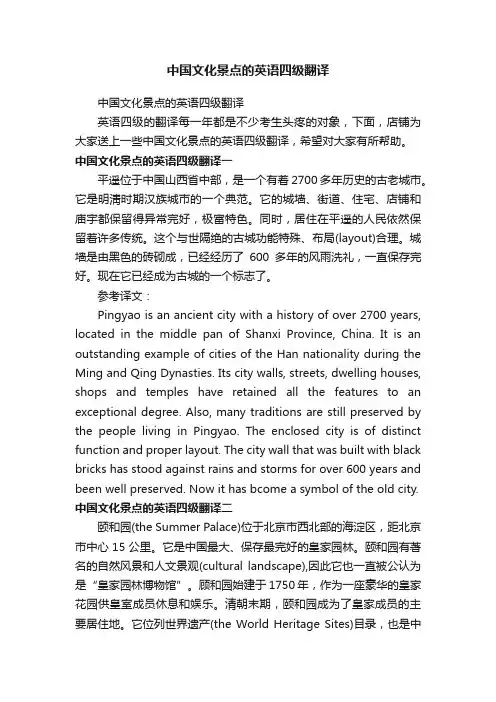
中国文化景点的英语四级翻译中国文化景点的英语四级翻译英语四级的翻译每一年都是不少考生头疼的对象,下面,店铺为大家送上一些中国文化景点的英语四级翻译,希望对大家有所帮助。
中国文化景点的英语四级翻译一平遥位于中国山西省中部,是一个有着2700多年历史的古老城市。
它是明淸时期汉族城市的一个典范。
它的城墙、街道、住宅、店铺和庙宇都保留得异常完好,极富特色。
同时,居住在平遥的人民依然保留着许多传统。
这个与世隔绝的古城功能特殊、布局(layout)合理。
城墙是由黑色的砖砌成,已经经历了600多年的风雨洗礼,一直保存完好。
现在它已经成为古城的一个标志了。
参考译文:Pingyao is an ancient city with a history of over 2700 years, located in the middle pan of Shanxi Province, China. It is an outstanding example of cities of the Han nationality during the Ming and Qing Dynasties. Its city walls, streets, dwelling houses, shops and temples have retained all the features to an exceptional degree. Also, many traditions are still preserved by the people living in Pingyao. The enclosed city is of distinct function and proper layout. The city wall that was built with black bricks has stood against rains and storms for over 600 years and been well preserved. Now it has bcome a symbol of the old city. 中国文化景点的英语四级翻译二颐和园(the Summer Palace)位于北京市西北部的海淀区,距北京市中心15公里。
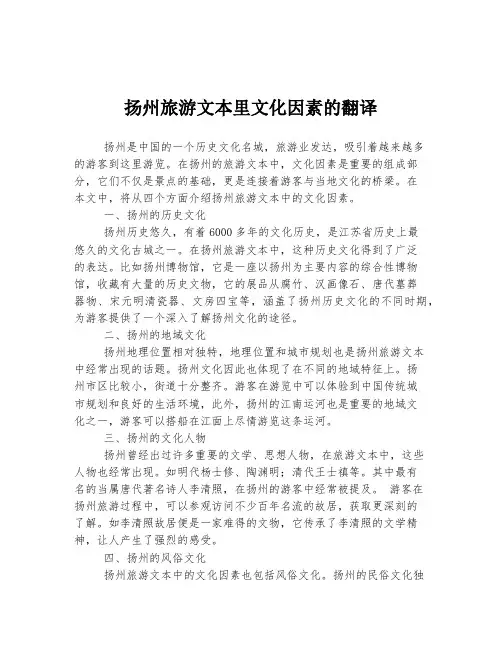
扬州旅游文本里文化因素的翻译扬州是中国的一个历史文化名城,旅游业发达,吸引着越来越多的游客到这里游览。
在扬州的旅游文本中,文化因素是重要的组成部分,它们不仅是景点的基础,更是连接着游客与当地文化的桥梁。
在本文中,将从四个方面介绍扬州旅游文本中的文化因素。
一、扬州的历史文化扬州历史悠久,有着6000多年的文化历史,是江苏省历史上最悠久的文化古城之一。
在扬州旅游文本中,这种历史文化得到了广泛的表达。
比如扬州博物馆,它是一座以扬州为主要内容的综合性博物馆,收藏有大量的历史文物,它的展品从腐竹、汉画像石、唐代墓葬器物、宋元明清瓷器、文房四宝等,涵盖了扬州历史文化的不同时期,为游客提供了一个深入了解扬州文化的途径。
二、扬州的地域文化扬州地理位置相对独特,地理位置和城市规划也是扬州旅游文本中经常出现的话题。
扬州文化因此也体现了在不同的地域特征上。
扬州市区比较小,街道十分整齐。
游客在游览中可以体验到中国传统城市规划和良好的生活环境,此外,扬州的江南运河也是重要的地域文化之一,游客可以搭船在江面上尽情游览这条运河。
三、扬州的文化人物扬州曾经出过许多重要的文学、思想人物,在旅游文本中,这些人物也经常出现。
如明代杨士修、陶渊明;清代王士禛等。
其中最有名的当属唐代著名诗人李清照,在扬州的游客中经常被提及。
游客在扬州旅游过程中,可以参观访问不少百年名流的故居,获取更深刻的了解。
如李清照故居便是一家难得的文物,它传承了李清照的文学精神,让人产生了强烈的感受。
四、扬州的风俗文化扬州旅游文本中的文化因素也包括风俗文化。
扬州的民俗文化独具特色,主要是由扬州的历史地位、繁荣经济所形成的文明和文化所衍生出来的。
例如,扬州独有的京剧、高邮花鼓戏、汉剧等剧种,在扬州的旅游文本中也被列入了一年之中不同的观赏时段。
此外,扬州春燕、翁婿戏、古代楼阁、传统美食等都是扬州独有的文化特色,游客在游览扬州时,也会受到强烈的感染。
总之,扬州的旅游文本中的文化因素是必不可少的。
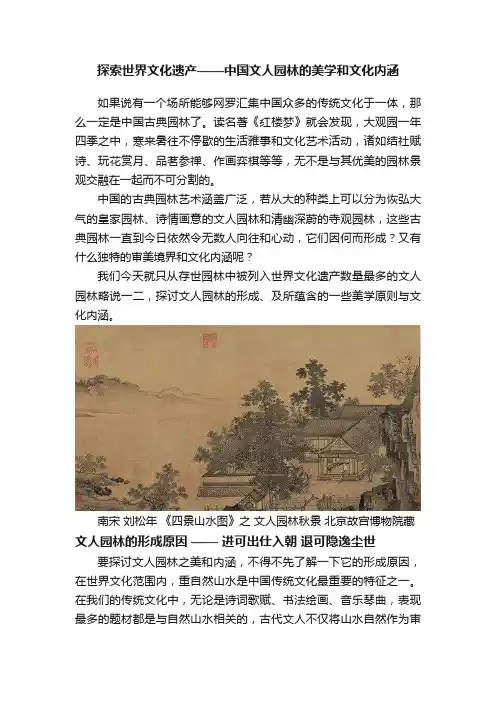
探索世界文化遗产——中国文人园林的美学和文化内涵如果说有一个场所能够网罗汇集中国众多的传统文化于一体,那么一定是中国古典园林了。
读名著《红楼梦》就会发现,大观园一年四季之中,寒来暑往不停歇的生活雅事和文化艺术活动,诸如结社赋诗、玩花赏月、品茗参禅、作画弈棋等等,无不是与其优美的园林景观交融在一起而不可分割的。
中国的古典园林艺术涵盖广泛,若从大的种类上可以分为恢弘大气的皇家园林、诗情画意的文人园林和清幽深蔚的寺观园林,这些古典园林一直到今日依然令无数人向往和心动,它们因何而形成?又有什么独特的审美境界和文化内涵呢?我们今天就只从存世园林中被列入世界文化遗产数量最多的文人园林略说一二,探讨文人园林的形成、及所蕴含的一些美学原则与文化内涵。
南宋刘松年《四景山水图》之文人园林秋景北京故宫博物院藏文人园林的形成原因——进可出仕入朝退可隐逸尘世要探讨文人园林之美和内涵,不得不先了解一下它的形成原因,在世界文化范围内,重自然山水是中国传统文化最重要的特征之一。
在我们的传统文化中,无论是诗词歌赋、书法绘画、音乐琴曲,表现最多的题材都是与自然山水相关的,古代文人不仅将山水自然作为审美对象,更是作为我们民族的精神文化承载。
魏晋时期竹林七贤的核心人物阮籍说:“山静而谷深者,自然之道也。
” 古人认为在与山水自然共处的状态中能达到物我两忘的澄澈辽远的境界,使自身人格得到滋养抚慰,远离世俗的喧嚣纷扰,距自然大道近了,也就距自我的真实心性近了。
从魏晋南北朝开始,隐逸文化迅速发展,出现了一批以竹林七贤、陶渊明等为代表的隐逸士人,他们悠游于山水间,并以此彰显自己独立的人格,明代文学家王思任曾说:“今古风流,惟有晋代。
”这些文人心中的精神领袖人物的生活方式大大影响了当时以及后来的上层社会。
清石涛《陶渊明诗意图册》共十二帧北京故宫博物院藏但不是所有人都能像陶渊明一样“采菊东篱下,悠然见南山”,也不是所有人都能像王羲之那样“遍游东中诸郡,穷诸名山,泛沧海,叹曰:‘我卒当以乐死’ ” ,文人士大夫于是试图在对山水自然的向往和现实生活的落地之间找寻一个平衡,将对自然山水的热爱之情倾注于对自己生活环境的改造中。
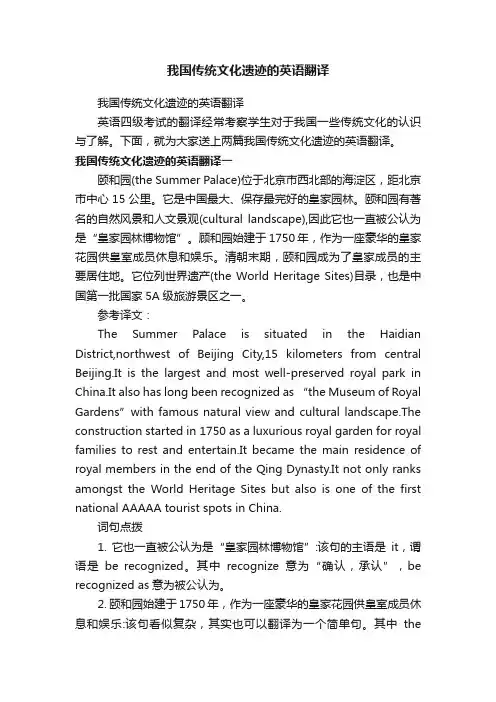
我国传统文化遗迹的英语翻译我国传统文化遗迹的英语翻译英语四级考试的翻译经常考察学生对于我国一些传统文化的认识与了解。
下面,就为大家送上两篇我国传统文化遗迹的英语翻译。
我国传统文化遗迹的英语翻译一颐和园(the Summer Palace)位于北京市西北部的海淀区,距北京市中心15公里。
它是中国最大、保存最完好的皇家园林。
颐和园有著名的自然风景和人文景观(cultural landscape),因此它也一直被公认为是“皇家园林博物馆”。
顾和园始建于1750年,作为一座豪华的皇家花园供皇室成员休息和娱乐。
清朝末期,颐和园成为了皇家成员的主要居住地。
它位列世界遗产(the World Heritage Sites)目录,也是中国第一批国家5A级旅游景区之一。
参考译文:The Summer Palace is situated in the Haidian District,northwest of Beijing City,15 kilometers from central Beijing.It is the largest and most well-preserved royal park in China.It also has long been recognized as “the Museum of Royal Gardens”with famous natural view and cultural landscape.The construction started in 1750 as a luxurious royal garden for royal families to rest and entertain.It became the main residence of royal members in the end of the Qing Dynasty.It not only ranks amongst the World Heritage Sites but also is one of the first national AAAAA tourist spots in China.词句点拨1. 它也一直被公认为是“皇家园林博物馆”:该句的主语是it,谓语是be recognized。
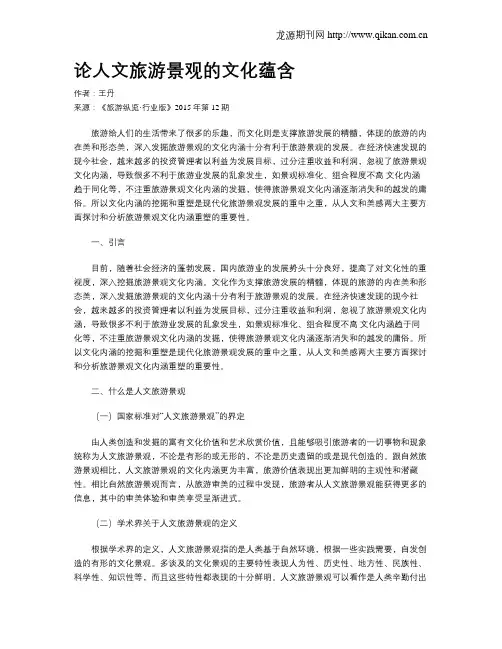
论人文旅游景观的文化蕴含作者:王丹来源:《旅游纵览·行业版》2015年第12期旅游给人们的生活带来了很多的乐趣,而文化则是支撑旅游发展的精髓,体现的旅游的内在美和形态美,深入发掘旅游景观的文化内涵十分有利于旅游景观的发展。
在经济快速发现的现今社会,越来越多的投资管理者以利益为发展目标,过分注重收益和利润,忽视了旅游景观文化内涵,导致很多不利于旅游业发展的乱象发生,如景观标准化、组合程度不高文化内涵趋于同化等,不注重旅游景观文化内涵的发掘,使得旅游景观文化内涵逐渐消失和的越发的庸俗。
所以文化内涵的挖掘和重塑是现代化旅游景观发展的重中之重,从人文和美感两大主要方面探讨和分析旅游景观文化内涵重塑的重要性。
一、引言目前,随着社会经济的蓬勃发展,国内旅游业的发展势头十分良好,提高了对文化性的重视度,深入挖掘旅游景观文化内涵。
文化作为支撑旅游发展的精髓,体现的旅游的内在美和形态美,深入发掘旅游景观的文化内涵十分有利于旅游景观的发展。
在经济快速发现的现今社会,越来越多的投资管理者以利益为发展目标,过分注重收益和利润,忽视了旅游景观文化内涵,导致很多不利于旅游业发展的乱象发生,如景观标准化、组合程度不高文化内涵趋于同化等,不注重旅游景观文化内涵的发掘,使得旅游景观文化内涵逐渐消失和的越发的庸俗。
所以文化内涵的挖掘和重塑是现代化旅游景观发展的重中之重,从人文和美感两大主要方面探讨和分析旅游景观文化内涵重塑的重要性。
二、什么是人文旅游景观(一)国家标准对“人文旅游景观”的界定由人类创造和发掘的富有文化价值和艺术欣赏价值,且能够吸引旅游者的一切事物和现象统称为人文旅游景观,不论是有形的或无形的,不论是历史遗留的或是现代创造的。
跟自然旅游景观相比,人文旅游景观的文化内涵更为丰富,旅游价值表现出更加鲜明的主观性和潜藏性。
相比自然旅游景观而言,从旅游审美的过程中发现,旅游者从人文旅游景观能获得更多的信息,其中的审美体验和审美享受呈渐进式。

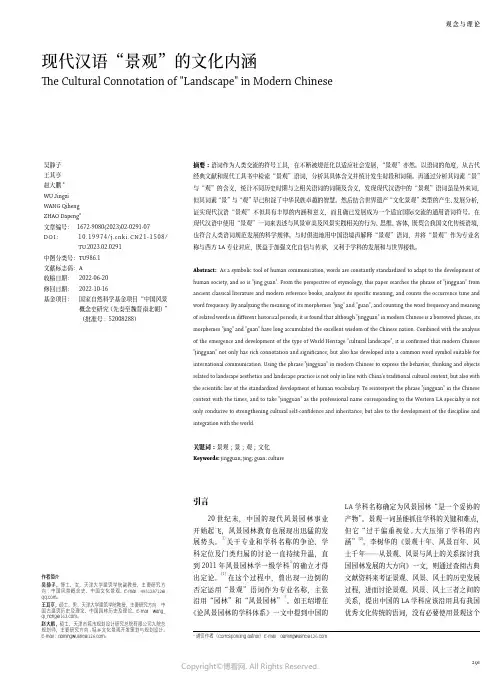
291观念与理论摘要:语词作为人类交流的符号工具,在不断被规范化以适应社会发展,“景观”亦然。
以语词的角度,从古代经典文献和现代工具书中检索“景观”语词,分析其具体含义并统计发生时段和词频。
再通过分析其词素“景”与“观”的含义,统计不同历史时期与之相关语词的词频及含义,发现现代汉语中的“景观”语词虽是外来词,但其词素“景”与“观”早已积淀了中华民族卓越的智慧。
然后结合世界遗产“文化景观”类型的产生、发展分析,证实现代汉语“景观”不但具有丰厚的内涵和意义,而且确已发展成为一个适宜国际交流的通用语词符号。
在现代汉语中使用“景观”一词来表述与风景审美及风景实践相关的行为、思维、客体,既契合我国文化传统语境,也符合人类语词规范发展的科学规律。
与时俱进地用中国语境再解释“景观”语词,并将“景观”作为专业名称与西方LA 专业对应,既益于加强文化自信与传承,又利于学科的发展和与世界接轨。
Abstract: As a symbolic tool of human communication, words are constantly standardized to adapt to the development of human society, and so is "jing guan". From the perspective of etymology, this paper searches the phrase of "jingguan" from ancient classical literature and modern reference books, analyzes its specific meaning, and counts the occurrence time and word frequency. By analyzing the meaning of its morphemes "jing" and "guan", and counting the word frequency and meaning of related words in different historical periods, it is found that although "jingguan" in modern Chinese is a borrowed phrase, its morphemes "jing" and "guan" have long accumulated the excellent wisdom of the Chinese nation. Combined with the analysis of the emergence and development of the type of World Heritage "cultural landscape", it is confirmed that modern Chinese "jingguan" not only has rich connotation and significance, but also has developed into a common word symbol suitable for international communication. Using the phrase "jingguan" in modern Chinese to express the behavior, thinking and objects related to landscape aesthetics and landscape practice is not only in line with China's traditional cultural context, but also with the scientific law of the standardized development of human vocabulary. To reinterpret the phrase "jingguan" in the Chinese context with the times, and to take "jingguan" as the professional name corresponding to the Western LA specialty is not only conducive to strengthening cultural self-confidence and inheritance, but also to the development of the discipline and integration with the world.关键词:景观;景;观;文化Keywords: jingguan; jing; guan; culture引言20世纪末,中国的现代风景园林事业开始起飞,风景园林教育也展现出迅猛的发展势头。
人文古迹的文化内涵人文古迹是一座城市或地区的文化瑰宝,它们以丰富的历史、艺术和建筑内涵吸引着无数游客的目光。
这些古迹承载着深厚的文化内涵,不仅是过去时代的见证,也是人类智慧和创造力的结晶。
本文将探讨人文古迹的文化内涵,并通过实例来展示它们在世界各地的重要性。
第一章古迹的历史背景古迹作为历史的见证,承载了属于过去的故事和记忆。
它们记录了人类社会的发展历程,展示了不同时期的政治、经济和文化特征。
例如,埃及的金字塔是古代文明的杰作,展示了古埃及人民对死亡和来世的信仰。
故宫则是中国明清两代皇宫的象征,见证了中国帝制时代的荣辱兴衰。
第二章古迹的艺术价值古迹作为艺术的瑰宝,展示了各个时期的建筑和雕塑艺术。
它们体现了当时社会的审美观念和工艺技术。
例如,米开朗基罗的《达芬奇的最后晚餐》是世界文化遗产,它以精湛的绘画技巧和深刻的主题表达了文艺复兴时期的思想和情感。
而巴黎圣母院则是哥特式建筑艺术的杰出代表,以其壮丽的结构和细致的雕饰令人叹为观止。
第三章古迹的建筑魅力古迹作为建筑的奇迹,展现了人类在设计和工程领域的成就。
它们体现了当时的建筑风格和技术特点,具有独特的建筑价值。
例如,卢浮宫是法国巴洛克风格建筑的代表作,以其宏伟的结构和精心设计的花园成为巴黎的地标。
而印度泰姬陵则是印度穆斯林建筑的杰作,以其对称的构图和精美的瓷砖装饰吸引了众多游客的目光。
第四章古迹的文化传承古迹作为文化的传承,承担着教育和研究的使命。
通过对古迹的保护和传承,人们可以深入了解历史和文化,从中汲取智慧和启示。
例如,雅典卫城是古希腊文明的象征,保存了丰富的文物和建筑遗址,通过对其的研究,我们可以更好地理解古希腊社会的政治和文化制度。
第五章古迹的旅游价值古迹作为旅游景点,吸引着来自世界各地的游客。
其壮丽的景观和丰富的文化内涵都成为旅游者探索和体验的对象。
例如,巴西的克里斯托瓦恩·科隆博山是世界七大奇迹之一,以其壮观的景色和丰富的生态资源成为世界级旅游目的地。
介绍常州文化的作文常州是一座有着三千多年历史的文化古城。
春秋末期,常州属于吴国,有着长达两千五百多年有准确纪年和确切地名的历史。
隋文帝开皇九年始有常州之称。
常州地处吴、楚、越的交汇地带,俗语讲:“苏湖熟,天下足”,在古代苏州、常州等苏南地区是主要的粮食产地,如果这两地粮食成熟了大丰收,就可以供给天下人。
诗人陆游盛赞常州:“常州儒风蔚然,为东南冠”。
常州历史文化名人众多,特别是近代孕育了以瞿秋白、张太雷、恽代英“常州三杰”为代表的革命先驱。
这里有着丰富的旅游资源——圩墩新石器遗址、春秋淹城、天目湖、金坛茅山风景区、太平天国护王府、瞿秋白纪念馆、中华恐龙园等,无论是历史古迹,还是人文景观,无不彰显着这座城市的文化底蕴。
译文:Changzhou is an ancient cultural city with a history of more than 3,000 years. At the end of the Spring and Autumn Period, Changzhou belonged to the state of Wu, with a history of more than 2,500 years with accurate chronology and exact place names. It was only nine years since Emperor Wendi of Sui opened the emperor that Changzhou was known. Changzhou is located at the intersection of Wu, Chu and Yue. As the saying goes, "Su Hu is ripe, and the world is abundant". It was the main grain producing area in ancient Suzhou, Changzhou and other southern Jiangsu areas. If the grain in these two places matured and had a bumper harvest, they could supply the world.Lu You, a poet, praised Changzhou: "Changzhou's Confucian style is very strong, and it is the southeast crown". There are many historical and cultural celebrities in Changzhou, especially the revolutionary pioneers represented by Qu Qiubai, Zhang Tailei and Hui Daiying in modern times. There are abundant tourist resources here-Weidun Neolithic Site, Chunqiu Yancheng, Tianmu Lake, Jintan Maoshan Scenic Area, Taiping Heavenly Kingdom's Palace, Qu Qiubai Memorial Hall, China Dinosaur Garden, etc., all of which show the cultural heritage of this city in terms of historical sites and cultural landscapes.。
Related Vocabulary●旅游tourism文化旅游cultural tourism旅游市场tourism culture旅游者tourist游客;访问者visitor旅行travel; to travel旅行家traveler世界旅行家world traveler旅游学院institute of tourism名胜place of interest; interesting place古迹site of historic significance; ancient monument有历史价值的ancient monument of historic value历史遗迹historical remains遗址ruins; remains旧址old site古墓ancient tomb访古to visit the historic sites探古to probe into the history自然景观natural landscape人文景观landscape of human characteristics人文景点scenic spot of human characteristics山水风景landscape游览名山大川to tour the famous mountains and big rivers游山玩水to tour scenic spots欣赏自然美景to appreciate the natural beauty欣赏自然风光to enjoy the natural scenery旅游to make a tour出国旅游to tour abroad周游世界to travel all over the world目的地destination到此一游to have an experience of traveling in a certain place走马看花take a quick glance to gain a superficial impression, just like watching flowers on horseback●台湾Taiwan香港Hong Kong澳门Macao新马泰Singapore, Malaysia and Thailand澳大利亚Australia北美North America加拿大Canada美国the United State; U.S.; America欧洲Europe英国the United King; U. K.; Britain伦敦London法国France巴黎Paris德国Germany意大利Italy俄国Russia圣彼得堡Saint Petersburg福利国家welfare state联合国教科文组织the United Nations Educational, Scientific and Cultural Organization; UNESCO●含义implication文化含义cultural implication文化内cultural connotation文化背景cultural background文化修养cultural accomplishment; cultural attainment;cultural achievement文化修养高的highly' cultivated提高文化修养to make higher cultural attainments文化遗产cultural heritage; cultural legacy<世界文化遗产名录) the World Cultural Heritage List 文化遗产保护preservation of cultural heritage文化品位cultural refinement陶冶;熏陶to edify文化熏陶cultural influence; cultural edification受文化熏陶to be influenced by culture;to be edified culturally陶冶情操的edifying●考察to make investigations进行学术交流to make academic exchanges参加国际会议to attend an international conference厌倦to be tired of难得清闲to find it hard to have a moment's leisure呼吸新鲜空气to breathe fresh air; to inhale fresh airto take in fresh air; to get a breath of fresh a寻求宁静to seek for peace远离尘世to keep oneself far away from the turmoil of thehuman world回归自然to retreat to Nature; to return to Nature打麻将to play mahjong大幅度增长to increase by a big margin;to increase by a great range留下足迹to leave one's track留下身影to cast one's shadow向往to yearn for增光添色to add colour to; to add luster to赞成看法to appreciate one's viewpoints被列入名单to be put in a list; to be included in a list保护文化遗产to preserve cultural relics保护历史遗产to protect historic heritage任重道远to shoulder heavy responsibilities树立奋斗目标to set up a goal for one's endeavour使命运发生重大转折to make an important turn in one's destiny 修缮古建筑物to repair an ancient building;to renovate an ancient building修旧如旧to repair an ancient building as it was修盖新建筑物to put up a new building;to erect a new building改造旧城镇to transform the old cities and towns推倒to knock down; to topple down; to tear down;to pull down; to raze; to demolish夷为平地to level to the ground; to raze to the ground产生矛盾There has arisen a contradiction.重视to attach great importance to将…定为to set.., as处理好…的关系to handle well the relationship between拨款to allocate funding; to allocate funds劳民伤才财to tire the people and drain the treasury;to waste money and manpower有充裕时间to have ample time; to have enough time;to have sufficient time采取严格措施to take strict measures随意破坏to destroy at will抹掉痕迹to erase the traces嘲笑to mock at; to laugh at●平日weekdays周末weekend节日festival春节Spring Festival假日holiday; day off国际劳动节International Labour Day国庆节National Day●世外桃源 a peaceful land of delight;a fictitious land of peace;a heaven of peace闹市的喧嚣clamour of city life; uproar of urban life;loud noise of the busy streets in the city人世间的烦恼worldly annoyance荒地wasteland●地理的geographical历史的historic; historical历史文物historic relics历史背景historic background历史遗产historic heritage历史价值historic value历史知识historical knowledge文物保护preservation of cultural relics;protection of historic relics文物管理部门administrative department in charge of cultural relics 重点文物保护单位key unit for protection of historic heritage;key unit for preservation of cultural relics假古董fake antique●前者the former后者the latter历来all along空间的spatial时间的temporal崭新的completely new有关法律规定The concerning law stipulates that物质消费material consumption物质享受material enjoyment; material comfort精神财富spiritual, wealth精神享受spiritual enjoyment; spiritual comfort精神的戴体carrier of the spirit鉴赏能力appreciative ability; power of appreciation艺术价值artistic value人生意义significance of human life永恒主题eternal theme魅力appeal审美情操;审美观aesthetic judgment; aesthetic values;aesthetic taste; aesthetic flavour智慧结晶crystallization of wisdom古代文明ancient civilization重宴依据. important ground博大精深broadness and profundity巨款large amount of money/funding;immense amounts of money/funding名城famous city历史名城famous city of historic importance历史见historical witness历史价值historic value历史的痕迹traces of history名人famous person; great personage; personage;eminent person; prominent person;notable person; distinguished person;celebrity历史人物historic figure历史名人notable historic figure名人故居former home of a famous person名人纪念馆memorial hall of a famous person世界驰名的world-famous历史博物馆museum of history; history museum艺术博物馆museum of art; art museum建筑单位construction unit古建筑物ancient building; ancient structure古建筑群groups of ancient structures;ancient architectural complex仿古建筑building of pseudo-classic architecture;structure in pseudo-classic style豪华宫殿luxurious royal palace宫殿建筑palace building皇家园林royal garden柱column; pillar青砖grey/gray brick; blue brick琉璃瓦glazed tile故宫Imperial Palace故宫博物院Palace Museum颐和园Summer Palace长城Great Wall天坛Temple of Heaven圆明园遗址the ruins of the Y uanmingyuan Palace十三陵Ming Tombs大英博物馆British Museum卢浮宫Louvre冬宫艺术博物馆Winter Palace Art Museum最高艺术殿堂supreme hall of art艺术宝库art treasure house; art treasury馆藏art collection展品exhibit艺术品artistic works艺术精品excellent artistic works艺术珍品quality works of art; excellent artistic articles造工精湛的with exquisite craftsmanship价值连城的priceless乱涂scribbles令人遗憾的事情matter of regretA: Since I was young, I have been fond of touring the famous mountains and big rivers in our country. Five years ago, I went to see some of my relatives in Taiwan and visited Hong Kong and Macao on my way back. In recent years, I have had opportunities to tour abroad, paying a visit first to Singapore, Malaysia and Thailand, and then to Australia. As a scientist, I've been to Canada and the United States in North America where I made investigations and academic exchanges. And I've also beento such European countries as Britain, France, Germany and Italy to attend international conferences. So I can be said to have traveled all over the world. You are an expert on the study related to tourism. So today I'd like to have a discussion with you about the implications of tourism culture.B: You are worthy of being called a "world traveler", having been to more places than I. In the weekdays, people living in the cities are busy with working and making money, and reluctant to take a rest, thus finding it hard to have a moment's leisure. Quite a lot of them are tired of the clamour of city life. At weekends, during festivals or on holidays, they would go to the mountainous areas or the open country to breathe fresh air, seek for peace and take a good rest. Some of them try to find a peaceful land of delight and keep themselves far away from the turmoil of the human world. Some others try to retreat to Nature, where they will forget the worldly annoyance and anxiety. The characteristic of this kind of tourism lies in its being a tourism in the geographical and spatial senses, rather than a tourism in the historic and temporal senses. That is to say, they regard tourism purely as touring scenic spots and appreciating their natural beauty, but take little consideration of their cultural implications.A: With the rapid development of economy, the income of the people has increased by a big margin. They have gottheir pockets bulging with more money. Being dissatisfied with staying at home only to watch TV or play mahjong, they want to travel here and there, visiting places of interest and sites of historic significance, so as to widen their horizons. During the longer holidays such as the Spring Festival, International Labour Day and National Day, the number of tourists has redoubled. The prosperity of the tourism market has, in mm, pro-rooted the development of our national economy. It seems that tourism has become a fashion. You have just mentioned that the pure enjoyment of the natural scenery is simply making a tour in the geographical and spatial senses. But I don't understand what it means. Can you give me an explanation?B: Now the tourists in our country mostly choose the natural landscapes as their destination, while most tourists from the developed countries tend to see the landscapes of human characteristics with 'historic and cultural background. The former is simply making a tour in the geographical sense, while the significance of the latter consists in making a tour back in history, which can be called cultural tourism. People have begun toshow concern for and take into account the cultural implications of tourism. The rising of cultural tourism has changed their conventional ideas. Making a tour is no longer merely a material consumption and material enjoyment. Quite a lot of people are seeking for spiritual comfort while they are making a tour. Some others even take tourism as a channel to acquire knowledge. It is well-known that famous cities and towns of historic importance are found here and there in Europe, where former homes and memorial halls of famous people are prevalent. To my mind, the key to the celebrity of a city lies in the fact that there have appeared many eminent persons in it. We often associate famous people with famous cities. At the thought of a personage, one nat- urally thinks of the famous city where the personage lived and worked. And when we think of a famous city, we also naturally in turn think of those prominent people who once lived and worked there. On a visit to a well-known European city of historic importance, a tourist will surely visit the former homes and memorial halls of those celebrities, seeing with his own eyes the surroundings in which the notable historic figures created spiritual wealth, and feeling in person the value and significance of the spiritual wealth they created. Cultural tourism has become an indispensable component part of many people's cultural life. Those land-scapes of human characteristic where distinguished people have left their tracks and cast their shadows will enhance the tourists' appreciative ability and cultural accomplishment.A:Why are there more tourists from European countries who choose the landscapes of human characteristic than those from China?B:The number of such tourists from European countries takes up about 70% of the total number of the tourists. However, the corresponding number of such tourists from China takes up only 30% or more. I think there are mainly two reasons for this difference. First, European tourists generally receive education higher than Chinese tourists. Some European countries are welfare states, in which most people have the opportunity to go to university. Speaking generally, the higher education a person has received, the more profoundly he is culturally edified, and the higher cultural accomplishments he is able to make. Those who are highly cultivated often choose to visit those landscapes of human characteristics with rich cultural contents. Second, the governments of many European countries attach great importance to the protection of the former homes and memorial halls of great personages, museums of history, andmuseums of art. Ordinary people also have a strong sense of treasuring cultural heritage. At the scenic spots of human characteristics in those countries, you will not hear any loud noise, or see any litter like fruit peel, waste paper or plastic bottles on the ground. Nor will you find any scribbles on the wall, for instance, "Mr Jones has paid a visit to this place."A: I have visited the British Museum in London, the Louvre in Paris and the Winter Palace Art Museum in Saint Petersburg. These world-famous museums are the supreme halls of art which the tourists of various countries yearn for. No visitors will not be amazed at the abundance of the art collections they have, and at the high artistic value of the exhibits they display there. These art treasure houses have added colour to the cities where they are located. These museums have attracted the people all over the world for the appeal of the artistic works they keep. Obviously, art plays an important role in cultural tourism. In other words, art forms an eternal theme of cultural tourism.B: I fully appreciate your viewpoints. The museum preserves and demonstrates the excellent artistic works which have appeared in history. It is a place in which people's aesthetic judgment is cultivated, and also a cradle in which artistic talents are fostered. The number, quality and size of the museums possessed by a country or a city constitute important standards to measure its cultural refinement. Just as the tourists to Beijing will visit the Palace Museum, those to Paris will certainly visit the Louvre, and those to Saint Petersburg the Winter Palace Art Museum. These magnificent museums which used to be the luxurious royal palaces of the kings and emperors of the past dynasties preserve priceless high-quality works of art. Now they are all open to the public, attracting and receiving hundreds of thousands of visitors who hail from all comers of the world.A: In fact, the tourists from China are also paying more and more attention to cultural tourism. A visitor to Beijing will go sightseeing in the Palace Museum, the Summer Palace and the Great Wall. If he has ample time, he will visit the Temple of Heaven, the ruins of the Yuanmingyuan Palace and the Ming Tombs. Every of these historic sites is a carrier of the spirit of the ancient Chinese art, and also a crystallization of the wisdom of the ancient Chinese labouring people. With their plentiful cultural connotations, these historic heritages embody the traditional Chinese aesthetic values. Some of our landscapes of human characteristichave been included in the Worm Cultural Heritage List and acknowledged ail over the world. Take the Summer Palace for example. With its splendid palace buildings and beautiful landscapes, it makes up the biggest royal garden of historic values in our country. Besides its groups of large-sized ancient structures, it also has a collection of tens of thousands of pieces of historic relics, among which there are quite a lot of excellent artistic articles with exquisite craftsmanship. All these are important grounds for which the Summer Palace has been put in the World Cultural Heritage List.B: Visits to these ancient monuments of historic values will enable our people to acquire vivid historical knowledge, and have a good understanding of the broadness and profundity of our ancient civilization, so as to make higher cultural attainments. It is necessary for us to guide and foster our Chinese tourists, and help them comprehend the cultural implications of tourism. Making a tour to a landscape of human characteristic is by no means a mere experience of having traveled in a certain place and having taken a quick glance to gain a superficial impression, just like watching flowers on horseback. I myself came to understand the significance of human life in the course of visiting the historic sites and probing into history, finally setting up a goal for my endeavour. As a result, I made an important mm in my destiny.A: I also have the same idea. Travel is an edifying experience. Tourism, especially cultural tourism, has benefited me all my life.。
=语言与文化>文化内涵与旅游翻译浅论¹傅文(山东农业大学外语学院,山东泰安271018)[摘要]由于中外文化的差异,中外旅游者对旅游资源文化内涵的理解存在很大偏差,其中,旅游翻译具有至关重要的作用。
[关键词]文化差异;文化内涵;旅游翻译[中图分类号]H059[文献标识码]A[文章编号]1008-8091(2001)03-0080-02A brief disscussion on cultural connotation and travelling translationFU Wen(College of Foreign L anguages,S handong Ag ricultural Univ ersity,T ai.an,Shandong271018)Abstract:Because the foreign and Chinese culture are different,visitors from different countries may have dif-ferent connotations on scenic spots.To this point,travelling translation plays a very important part in it. Key words:cultural difference;cultural connotation;travelling translation大家都知道,对于汉英与英汉翻译,显然后者稍容易些。
因为,除少数人外,人们对母语的掌握会好于对外语的掌握。
国外翻译界人士普遍认为:一般情况下,翻译应以从译入本国(族)语为主,但我们需要对外宣传、推介自己,需要交流与合作,尤其在翻译工作中汉英翻译更是必不可少。
既然汉英翻译有一定的难度,那么在翻译过程中特别是旅游翻译工作中,出现一些错误和不足是难免的。
旅游翻译涉及的知识面非常广泛,囊括了中国民族文化的方方面面。
人文景观是什么意思
人文景观是指一个地区的景象,不同地貌、时间、人文会构成不同的景观,如城乡景观、自然景观、城市景观、乡村景观,日景、夜景等。
一些有特殊生态、人文、历史价值的景观往往会受到*** 保护,如特定建筑群、生态区等。
艺术上的景观又称为风景。
此外一些地区为了保护景观,会限制建筑物的高度、造型等。
人文景观是指具有一定历史性、文化性,一定的实物和精神等表现形式的旅游吸引物。
扩展资料:
人文景观,最主要的体现即聚落,还包括服饰、建筑、音乐等。
建筑方面的特色反映为城堡、宫殿,以及各类宗教建筑景观,具有历史性。
人文景观包括的范围很广,涉及面很宽,类型多样。
归纳起来,人文景观主要包括历史古迹、古典园林、宗教文化、民俗风情、文学与艺术、城镇与产业观光等类型。
共性说明:
1、有旅游吸引力
2、历史性,要求要一定的历史时期的积累。
3、文化性,需要有一定的文化内涵。
4、多种表现形式,可以是实物载体,像文物古迹,也可以是精神形式,像神话传说,民俗风情。